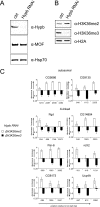Transcription-coupled methylation of histone H3 at lysine 36 regulates dosage compensation by enhancing recruitment of the MSL complex in Drosophila melanogaster
- PMID: 18347056
- PMCID: PMC2423169
- DOI: 10.1128/MCB.00006-08
Transcription-coupled methylation of histone H3 at lysine 36 regulates dosage compensation by enhancing recruitment of the MSL complex in Drosophila melanogaster
Abstract
In Drosophila melanogaster, dosage compensation relies on the targeting of the male-specific lethal (MSL) complex to hundreds of sites along the male X chromosome. Transcription-coupled methylation of histone H3 lysine 36 is enriched toward the 3' end of active genes, similar to the MSL proteins. Here, we have studied the link between histone H3 methylation and MSL complex targeting using RNA interference and chromatin immunoprecipitation. We show that trimethylation of histone H3 at lysine 36 (H3K36me3) relies on the histone methyltransferase Hypb and is localized promoter distal at dosage-compensated genes, similar to active genes on autosomes. However, H3K36me3 has an X-specific function, as reduction specifically decreases acetylation of histone H4 lysine 16 on the male X chromosome. This hypoacetylation is caused by compromised MSL binding and results in a failure to increase expression twofold. Thus, H3K36me3 marks the body of all active genes yet is utilized in a chromosome-specific manner to enhance histone acetylation at sites of dosage compensation.
Figures






References
-
- Akhtar, A., and P. B. Becker. 2000. Activation of transcription through histone H4 acetylation by MOF, an acetyltransferase essential for dosage compensation in Drosophila. Mol. Cell 5367-375. - PubMed
-
- Barski, A., S. Cuddapah, K. Cui, T. Y. Roh, D. E. Schones, Z. Wang, G. Wei, I. Chepelev, and K. Zhao. 2007. High-resolution profiling of histone methylations in the human genome. Cell 129823-837. - PubMed
-
- Bell, O., C. Wirbelauer, M. Hild, A. N. Scharf, M. Schwaiger, D. M. MacAlpine, F. Zilbermann, F. van Leeuwen, S. P. Bell, A. Imhof, D. Garza, A. H. Peters, and D. Schubeler. 2007. Localized H3K36 methylation states define histone H4K16 acetylation during transcriptional elongation in Drosophila. EMBO J. 264974-4984. - PMC - PubMed
-
- Carrozza, M. J., B. Li, L. Florens, T. Suganuma, S. K. Swanson, K. K. Lee, W. J. Shia, S. Anderson, J. Yates, M. P. Washburn, and J. L. Workman. 2005. Histone H3 methylation by Set2 directs deacetylation of coding regions by Rpd3S to suppress spurious intragenic transcription. Cell 123581-592. - PubMed
Publication types
MeSH terms
Substances
LinkOut - more resources
Full Text Sources
Molecular Biology Databases
